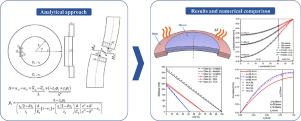Optics and Lasers in Engineering ( IF 3.5 ) Pub Date : 2021-11-20 , DOI: 10.1016/j.optlaseng.2021.106879 L. Esposito 1 , A. Bertocco 2 , M. Bruno 1 , A. Ruggiero 3

|
Interference-fit joints are typically adopted to produce permanent assemblies among mechanical parts. The resulting contact pressure is generally used for element fixing or to allow load transmission. Nevertheless, some special designs take advantage of the contact pressure to induce desiderata deformation or to mitigate the stress field inside the structure. Biased interference fitting between a planar mirror and an external ring could be used to induce the required curvature to realize new adaptive lens for optical aberration correction. Recently, thermally-actuated deformable mirror on this principle based, was proposed and prototyped. Although the feasibility and utility of such innovative lens was demonstrated, no comprehensive theory was developed to describe mirror behavior and predict their curvature. Nowadays, the use of approximated numerical approach, such as the finite element method, is the only way to study the interaction between biased and interference fitted bodies. The paper aims to give the theoretical background for the correct design of adaptive lens actuated by interference fitting. A new formulation for the curvature prediction is proposed and compared with finite element analysis and available experimental measurements.
中文翻译:

干涉拟合自适应光学设计:理论背景
过盈配合接头通常用于生产机械零件之间的永久组件。产生的接触压力通常用于元件固定或允许负载传输。然而,一些特殊的设计利用接触压力来引起所需的变形或减轻结构内部的应力场。平面镜和外环之间的偏置干涉拟合可用于产生所需的曲率,以实现用于光学像差校正的新型自适应透镜。最近,基于该原理的热驱动变形镜被提出并原型化。尽管证明了这种创新镜片的可行性和实用性,但没有开发出全面的理论来描述镜子的行为并预测它们的曲率。如今,使用近似数值方法,例如有限元方法,是研究偏置拟合体和干涉拟合体之间相互作用的唯一方法。本文旨在为正确设计干涉拟合驱动的自适应透镜提供理论背景。提出了一种新的曲率预测公式,并与有限元分析和可用的实验测量进行了比较。











































 京公网安备 11010802027423号
京公网安备 11010802027423号